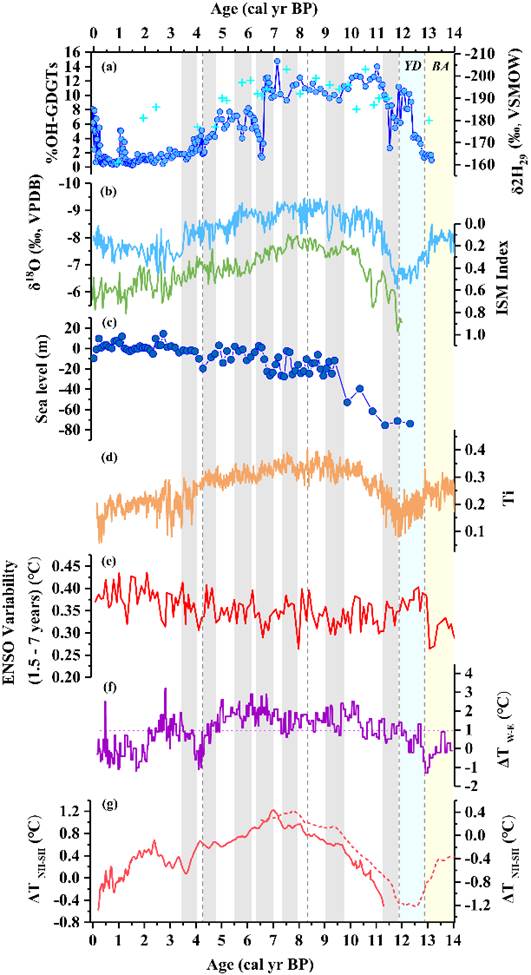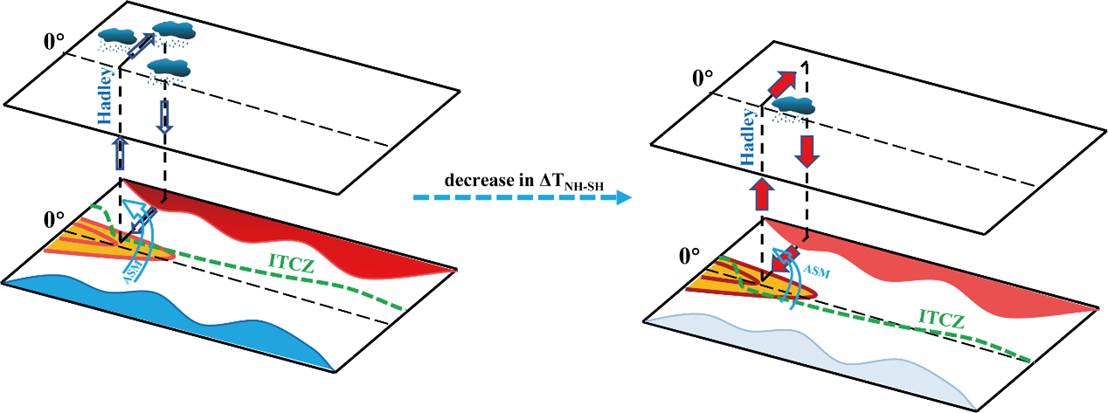The East Asian monsoon region's ecosystems, socioeconomic systems, and human civilizations are heavily dependent on the intensity and distribution of monsoon precipitation. During the Neolithic period, population movements across the Hu Huanyong Line into wetter western areas corresponded with changes in rainfall. Extreme drought events have been linked to the collapse of civilizations. Understanding the hydrological evolution, particularly the spatiotemporal patterns and triggers of drought events in the East Asian monsoon region, is crucial for maintaining ecosystems and supporting socioeconomic development.
Professor Zhou Aifeng's team from the laboratory has made significant progress in this field. Using indicators such as GDGTs and δDwax, they reconstructed the high-resolution hydrological history of Daihai Lake since the Last Glacial Maximum. Focusing on the major extreme drought events during the Holocene and their potential climate drivers, the team compared these results with other hydrological records from the East Asian monsoon region. The findings reveal that both monsoon and non-monsoon precipitation increased during 11.0–6.5 cal kyr BP, with Daihai Lake reaching its highest Holocene water levels. However, a significant 200-year drought (6.5–6.3 cal kyr BP) marked the end of the wet period in northern China. A comprehensive analysis of hydrological records from the East Asian monsoon region shows that while both northern and southern China experienced overall wetter conditions in the early Holocene, northern China witnessed two extreme drought events due to the suppressive effect of the Northern Hemisphere ice sheet on the Asian summer monsoon. During the mid-to-late Holocene, extreme drought events occurred synchronously across the East Asian monsoon region, likely driven by the southward migration of the ITCZ, controlled by the inter-hemispheric temperature gradient. Additionally, enhanced Hadley Cell circulation, which blocked the Asian summer monsoon, is thought to have contributed to the synchronous occurrence of droughts across the region. These findings were recently published inCommunications Earth & Environmentunder the title "Drought in the Asian summer monsoon region is linked to a weakened inter-hemispheric temperature gradient."

Figure 1: The Link Between Extreme Drought Events in the Asian Summer Monsoon Region and Ocean-Atmosphere Circulation


Figure 2: Mechanism Diagram Illustrating How a Weakened Inter-Hemispheric Temperature Gradient Leads to Extreme Drought Events in East Asia
OH-GDGTs, a class of lipids with hydroxyl groups similar to the isoGDGTs produced by aquatic archaea (e.g., Crenarchaeol), are considered reliable paleohydrological proxies. In 2021, Professor Zhou's team published the first quantitative equation of %Cren for reconstructing lake water depth inQuaternary Science Reviewsand applied it to a 2,000-year reconstruction of water levels at Daye Lake, Mount Taibai (Chen et al., 2021). In this study, they explored the potential of %OH-GDGTs as a proxy for quantitative paleowater level reconstruction, supported by elevation data of lake terraces. They found a significant positive correlation between %OH-GDGTs and δDwax, further proving the reliability of %OH-GDGTs as a paleohydrological indicator.
Professor Zhou Aifeng from the Key Laboratory of Western China's Environmental Systems, Ministry of Education, at Lanzhou University, is the corresponding author of the paper. The first author is Chen Lin, a doctoral student enrolled in 2021. Other co-authors include Li Mengjing, a master's student from the School, Dr. Chen Jie from the Institute of Tibetan Plateau Research, Chinese Academy of Sciences, Dr. Shen Zhongwei from Hunan Normal University, Associate Researcher Zhao Jiajun from the Institute of Earth Environment, Chinese Academy of Sciences, Professor Huang Xianyu from China University of Geosciences (Wuhan), and Professor Liu Jianbao from Peking University. The research was funded by the National Natural Science Foundation of China (Grant No. 42171153) and the “Basic Science Center for the Tibetan Plateau Earth System” project (Grant No. 41988101).
Related Publications:
Chen, L., Chen, J., Shen, Z.W., Zhao, J.J., Li, M.J., Huang, X.Y., Liu, J.B., Zhou, A.F.*, 2024. Drought in the Asian summer monsoon region is linked to a weakened inter-hemispheric temperature gradient.Communications Earth & Environment, 5: 432.https://doi.org/10.1038/s43247-024-01603-4
Chen, L., Huang, Z.D., Niu, L.L., Dong, W. M., Xiao, S., Chen, S.Q., Zhao, J.J., Wu, D., Zhou, A.F.*, 2021. GDGTs-based quantitative reconstruction of water level changes and precipitation at Daye Lake, Qinling Mountains (central-east China), over the past 2000 years.Quaternary Science Reviews267, 107099.https://doi.org/10.1016/j.quascirev.2021.107099